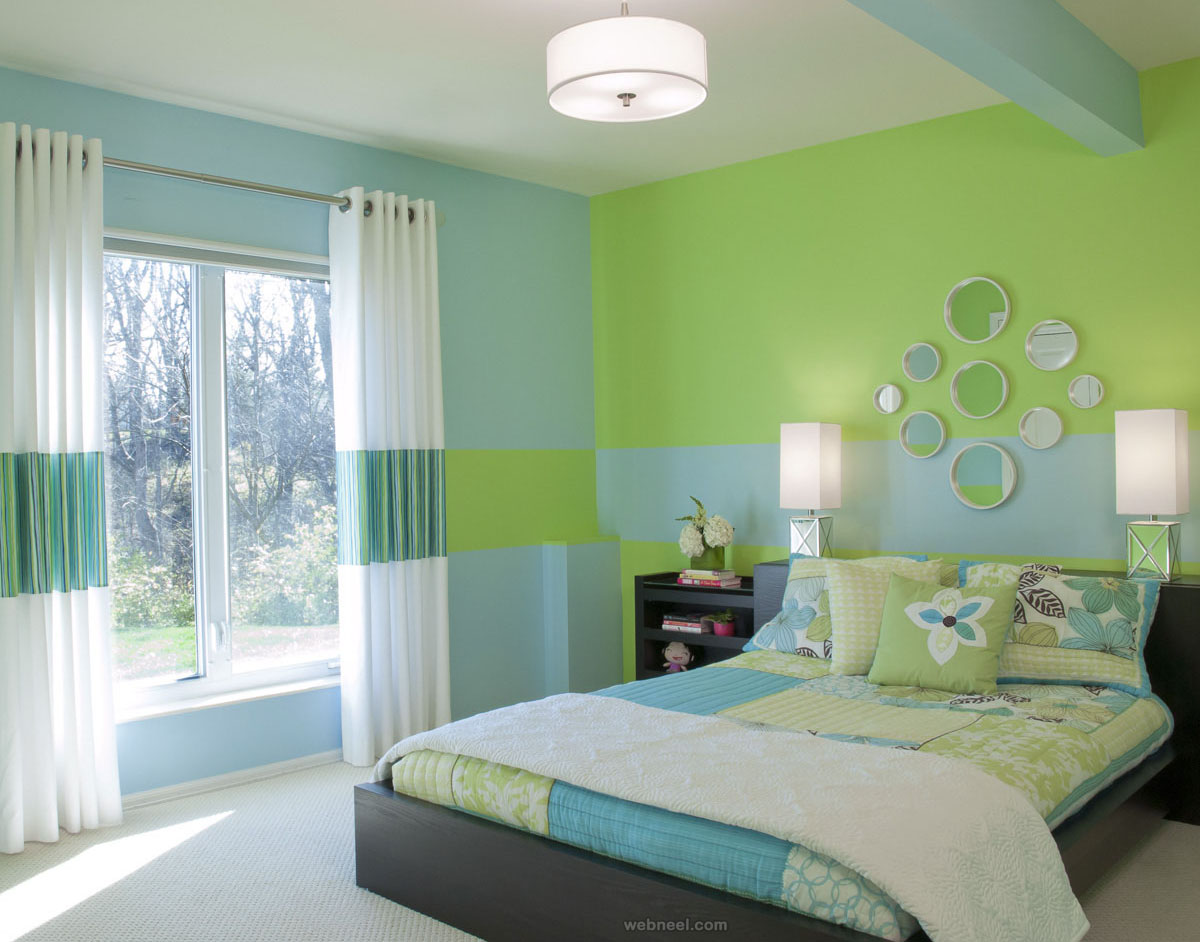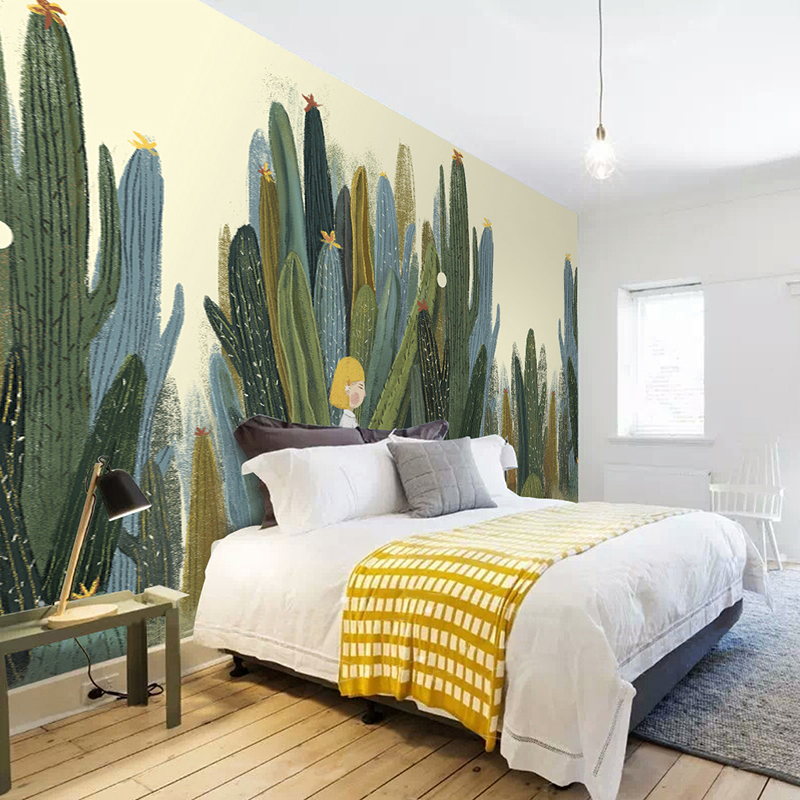Color Psychology and Mood
/blue-green-yellow-56a08eee3df78cafdaa2b5bf.jpg)
The colors blue, green, and yellow are frequently used in bedroom design because of their perceived calming and relaxing effects. These colors can have a profound impact on the mood and atmosphere of a bedroom, influencing sleep quality, relaxation, and overall well-being.
The Impact of Blue, Green, and Yellow on Mood and Atmosphere
Blue, green, and yellow are often associated with specific emotions and feelings. Blue is commonly linked to tranquility, peace, and calmness. Green evokes feelings of serenity, growth, and harmony. Yellow, on the other hand, is associated with happiness, optimism, and energy. These color associations can significantly influence the overall mood and atmosphere of a bedroom.
The Psychological Effects of Blue, Green, and Yellow on Sleep Quality and Relaxation
- Blue: Blue is a calming color that can promote relaxation and sleep. Studies have shown that exposure to blue light can suppress the production of melatonin, a hormone that regulates sleep-wake cycles. However, the calming effect of blue can be beneficial for creating a peaceful and restful atmosphere in the bedroom, especially when used in darker shades.
- Green: Green is considered a restorative color that can promote relaxation and reduce stress. Its association with nature can create a sense of tranquility and peacefulness, conducive to a good night’s sleep.
- Yellow: Yellow is often associated with energy and happiness, which may not be ideal for promoting sleep. However, certain shades of yellow, such as pale yellow or cream, can create a warm and inviting atmosphere that can be calming and relaxing.
Color Use in Different Bedroom Styles
- Minimalist Bedroom: Minimalist bedrooms often feature a neutral color palette with accents of blue or green. These colors can add a touch of tranquility and sophistication to the space without overwhelming the minimalist aesthetic.
- Bohemian Bedroom: Bohemian bedrooms often embrace a vibrant and eclectic mix of colors. Yellow can be used as an accent color to add a touch of warmth and energy to the space, while blue and green can be incorporated into patterns and textiles to create a sense of depth and texture.
- Traditional Bedroom: Traditional bedrooms often feature a more formal color palette, with muted shades of blue and green being popular choices. These colors can create a sense of elegance and sophistication, while still maintaining a calming and restful atmosphere.
Design Inspiration and Ideas: Blue Green Yellow Bedroom

A blue, green, and yellow bedroom can be a calming and energizing space, depending on the specific color combinations and design elements used. By exploring different color palettes, incorporating natural elements, and selecting furniture and textiles that complement the overall theme, you can create a bedroom that reflects your personality and fosters a sense of tranquility and joy.
Examples of Bedrooms with Blue, Green, and Yellow Color Palettes
These examples showcase how different shades of blue, green, and yellow can be used to create diverse and appealing bedroom designs.
- A bedroom with a soft blue wall, accented with a vibrant yellow headboard and green throw pillows, creates a calming and cheerful atmosphere. The blue provides a sense of tranquility, while the yellow adds energy and warmth. The green accents balance the colors and bring a touch of nature into the space.
- A bedroom with a deep teal wall, paired with white furniture and pale yellow bedding, offers a sophisticated and elegant feel. The teal provides a sense of depth and richness, while the white and yellow add brightness and contrast. The combination creates a calming and inviting space that is both stylish and functional.
- A bedroom with a sunny yellow wall, complemented by light green accents and blue furniture, creates a cheerful and uplifting space. The yellow promotes positivity and energy, while the green brings a sense of freshness and tranquility. The blue furniture adds a touch of sophistication and balances the overall color scheme.
Mood Board Design
A mood board is a visual representation of your design ideas, incorporating color combinations, textures, and design elements. It can serve as a valuable tool to guide your design process and ensure a cohesive and aesthetically pleasing outcome.
- Color Combinations: Explore different color palettes within the blue, green, and yellow spectrum. Consider using analogous colors, such as blue, green, and yellow, or complementary colors, such as blue and orange or green and red. The choice of color combinations will significantly impact the mood and feel of your bedroom.
- Textures: Incorporate a variety of textures to add depth and visual interest to your bedroom. For example, consider using soft velvet bedding, woven rugs, and textured wall coverings.
- Design Elements: Select design elements that complement your chosen color palette and overall theme. These elements can include artwork, plants, lighting fixtures, and decorative accessories.
Bedroom Layout Design
Creating a functional and aesthetically pleasing bedroom layout requires careful consideration of furniture placement, lighting, and textiles.
- Furniture Placement: Arrange your furniture to maximize space and create a comfortable flow. Consider using a bed frame with storage drawers to optimize space, and place a dresser or vanity strategically for easy access. Ensure ample walking space around the furniture and create designated areas for specific activities, such as reading or dressing.
- Lighting: Incorporate different types of lighting to create a multi-layered and functional space. Use a combination of overhead lighting, such as a ceiling fixture or pendant lamp, and task lighting, such as bedside lamps or desk lamps. Consider using dimmable lights to adjust the mood and ambiance of your bedroom.
- Textiles: Textiles play a crucial role in creating a comfortable and inviting atmosphere. Consider using soft and luxurious bedding, such as Egyptian cotton or linen, and incorporate throw pillows and blankets in complementary colors and textures. Add a rug to define the space and create a sense of warmth and comfort.
Practical Considerations

Creating a bedroom that blends blue, green, and yellow is an exciting endeavor, but it requires careful planning to ensure a harmonious and practical outcome. This section delves into the practical aspects of designing such a space, considering the impact of natural light, color combinations, and a step-by-step guide for painting the room.
Impact of Natural Light on Color Perception
Natural light plays a crucial role in how colors are perceived. The amount and type of light influence the shade and intensity of the colors in a room. Understanding this relationship is essential when choosing colors for a blue, green, and yellow bedroom.
- Sunlight: Abundant sunlight can make colors appear brighter and more vibrant. This effect can be particularly noticeable with yellow, which can become almost blindingly bright in direct sunlight. In contrast, blue and green hues may appear less saturated, leaning towards a lighter, more pastel tone.
- Artificial Light: Artificial light sources, such as incandescent or fluorescent bulbs, can cast a different color cast on the room. This can significantly alter the perception of the chosen colors. For example, incandescent bulbs can make yellows appear warmer, while fluorescent bulbs can make blues appear cooler.
- Room Orientation: The orientation of the bedroom (north, south, east, or west) affects the amount of sunlight it receives throughout the day. Rooms facing south receive the most direct sunlight, while rooms facing north receive the least. This variation in light exposure will influence the perceived color of the walls and furnishings.
To ensure a harmonious balance, it is crucial to consider the natural light conditions in the bedroom when selecting the shades of blue, green, and yellow. Experimenting with color samples under different lighting conditions is highly recommended to avoid surprises.
Complementary Colors and Accents
Complementary colors are those that appear opposite each other on the color wheel. They create a visually stimulating contrast and enhance the overall design. In the context of a blue, green, and yellow bedroom, utilizing complementary colors can add depth and vibrancy.
- Blue and Orange: Blue, a cool color, pairs well with orange, a warm color. This combination can create a dynamic and energetic atmosphere. For example, adding orange throw pillows or artwork to a blue-walled bedroom can add a pop of warmth and energy.
- Green and Red: Green and red are complementary colors that can create a striking contrast. Using red accents, such as a red rug or a red headboard, against a green backdrop can add a touch of drama and sophistication.
- Yellow and Purple: Yellow and purple are complementary colors that can create a vibrant and playful atmosphere. Using purple accents, such as a purple lampshade or a purple duvet cover, against a yellow backdrop can add a touch of whimsy and sophistication.
Beyond complementary colors, consider incorporating accent colors that complement the primary color scheme. For example, adding touches of white, cream, or gray can help to create a sense of balance and harmony.
Painting a Bedroom with Blue, Green, and Yellow, Blue green yellow bedroom
Painting a bedroom with a combination of blue, green, and yellow requires careful planning and execution. Here is a step-by-step guide to achieve a successful outcome:
- Prepare the Walls: Begin by cleaning the walls thoroughly with a damp cloth to remove dust, dirt, and grease. Fill any cracks or holes with spackle and let it dry completely. Sand the spackled areas smooth to ensure a seamless finish.
- Choose Your Colors: Select shades of blue, green, and yellow that complement each other and create the desired mood. Consider the impact of natural light on the perceived color and select shades that work well in your bedroom’s lighting conditions.
- Tape Off Areas: Use painter’s tape to protect areas that you don’t want to paint, such as trim, windows, and doors. Ensure the tape is securely attached to avoid paint bleed.
- Prime the Walls: Apply a coat of primer to the walls to create a smooth, even surface for the paint to adhere to. Allow the primer to dry completely before proceeding.
- Paint the Walls: Start by painting the largest area, such as the main wall, with the dominant color (blue, green, or yellow). Use long, even strokes and avoid overloading the brush. Allow the paint to dry completely before applying the next coat.
- Add Accent Colors: Once the dominant color is dry, paint the accent walls with the remaining colors. You can create a focal point by painting one wall a different color or use stripes or geometric patterns for a more dynamic look.
- Remove Tape: Carefully remove the painter’s tape once the paint is completely dry. Ensure the tape is pulled away from the wall at a 45-degree angle to avoid paint peeling.
Remember to wear protective gear, such as gloves and a mask, during the painting process. Allow the paint to dry completely before adding furniture and accessories.
Blue green yellow bedroom – A blue, green, and yellow bedroom can be a vibrant and playful space, but if you want to add a touch of cool and calming energy, consider incorporating blue LED lights for your bedroom. Blue light can be incredibly soothing and promote relaxation, creating a more tranquil atmosphere in your blue, green, and yellow haven.
A blue green yellow bedroom can evoke a sense of calm and tranquility, especially when you incorporate pops of light blue. To elevate the space, consider adding some light blue bedroom accessories , like a throw pillow or a vase.
These subtle touches can tie the color scheme together and add a touch of sophistication to your blue green yellow haven.
